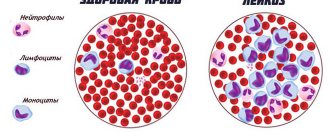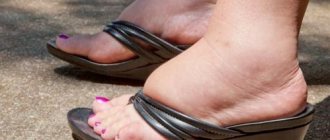Every day, a pregnant woman’s body undergoes many dramatic changes associated with the birth and development of a new life. One of these changes is an increase in the volume of fluid circulating in the body, as a result of which the expectant mother may experience swelling throughout the body. Swelling can also be caused by hormonal changes that provoke excessive thirst, and in some cases, severe swelling can be a sign of serious pathologies that can threaten the life of not only the mother, but also the child.
Below we describe in detail why the legs and arms swell during gestation, and in general all the reasons why edema forms during pregnancy will be outlined, and how to get rid of them in the early and late stages of gestation.
What to do in each specific case and what methods to use can only be told to a pregnant woman by the attending obstetrician-gynecologist. We only provide generalized information about the most commonly prescribed medications, interventions and recommendations that are used to combat swelling during pregnancy.
Causes of swelling during pregnancy
Edema is the accumulation of fluid in the body in the intercellular space of any organ or part thereof. During gestation, such a phenomenon can occur due to physiological factors, or can be caused by various pathologies.
Physiological reasons
80% of any person is water. During the period of bearing offspring, a woman gains about 10 kg, half of this weight comes from liquid. Physiological edema is the accumulation of water in the tissues of a pregnant woman, provoked by an increased sodium content, which retains fluid in the body. In the last weeks of pregnancy, sodium levels can rise significantly, which causes swelling in the limbs and body as a whole.
Thus, there is no reason to panic if a pregnant woman, especially in the third trimester, begins to slightly swell her calves and feet in the afternoon or towards night. Also considered normal is swelling of the genitals and swelling of the nasal mucosa, which provokes difficulty in nasal breathing in the last month of gestation.
Pathological
Swelling in pregnant women can also occur as a result of various pathological conditions. Let us consider in more detail each type of such diseases.
Kidney problems
During gestation, a woman’s kidneys are placed under enormous stress, as a result of which kidney diseases can worsen and even develop, causing swelling. Most often, the accumulation of fluid in this case is observed in the face area, it looks puffy, the eyelids especially swell, bruises appear due to gases and the number of trips to the toilet “in small ways” decreases. Swelling of the arms, particularly the wrists and hands, often develops. The main diagnostic method in this case is a urine test; if edema is caused by kidney problems, the analysis will show the presence of protein in the urine.
Cardiac edema
During gestation, the volume of blood flowing in a woman’s body increases by almost half, which becomes an additional load for the “pump” that pumps it, that is, for the heart.
If a woman has heart problems, this may be indicated by swelling in the body, the formation of which will occur in the direction of gravity:
- if the patient constantly stands, swelling develops in the legs;
- If a pregnant woman is constantly in a lying position, her stomach and back will swell.
In addition to swelling, such patients have shortness of breath, mucous membranes turn blue, and persistent palpitations are noted.
Internal swelling
These are so-called hidden edema, which are not visible from the outside, but pose a huge danger to the development of the fetus.
Hidden swelling most often develops on the uterus, on the abdominal walls and in the placenta, which can cause compression of the umbilical cord vessels, and this can lead to the development of fetoplacental insufficiency.
Intestinal disorders
Swelling of the legs during pregnancy can be caused by problems in the digestive tract, for example, the limbs can swell due to intestinal dysfunction and frequent diarrhea.
Preeclampsia
Preeclampsia is a complication of pregnancy, which is the main cause of death in women at the end of pregnancy and several times increases the likelihood of death of the fetus or child in the first weeks after birth. Characteristic symptoms of the development of gestosis are severe hidden and visible edema, proteinuria, and high blood pressure. The more severe the manifestations of gestosis, the more points the condition is given on the Savelyeva scale:
- 0 points – no swelling;
- 1 point – swelling in a pregnant woman may appear on the legs (legs) or the woman’s weight generally increases; most often such swelling accompanies the 3rd trimester (36-40 weeks) and the birth itself;
- 2 points – the legs and anterior abdominal wall swell, most often at 30-35 weeks;
- 3 points are assigned to generalized edema that occurs in the early stages of pregnancy or accompanies the 2nd trimester.
Table — assessment of the severity of gestosis in points.
Thrombophlebitis
If a pregnant woman has swelling of her legs accompanied by pain in the thigh and lower leg, or one limb swells more than the other, you should immediately seek medical help, as these may be signs of thrombophlebitis.
Additionally, there may be an increase in temperature and redness of the skin on the legs.
Varicose veins
Pregnant women who suffer from varicose veins often have swollen legs, since the fetus, which is constantly increasing in size, aggravates the course of the disease and additionally loads the venous vessels already affected by the pathology.
Thyroid problems
If there are problems in the functioning of the endocrine organs and in particular the thyroid gland, not only the lower limbs, but also the tongue may swell. Additionally, the woman feels severe fatigue, fatigue, and a constant desire to sleep. Digestive problems may occur, and constipation usually develops.
Diseases of viral etymology
Recent viral illnesses can cause swelling in a pregnant woman. An infection wandering in the body causes complications on the kidneys; they function worse, as a result of which fluid is retained in the body, which causes swelling of the lower extremities.
Causes and symptoms
The reason why edema appears in late pregnancy is high levels of progesterone. All other causes are considered secondary or a consequence of the action of this substance.
The amount of this hormone constantly increases during pregnancy, and sharply decreases only before childbirth. The main function of this hormone is to relax the smooth muscles of the uterus for normal childbearing. But at the same time, progesterone increases the permeability of the vascular wall. And starting from such a side effect, it is possible to explain the mechanism of development of almost all edema, which can be divided into two groups - physiological and pathological.
Physiological edema during pregnancy, which does not accompany pathology and is quite easily eliminated, occurs in several cases:
- Mechanical compression of blood vessels and ureters. Displaced organs and a growing uterus narrow the lumen of blood vessels and ureters, complicating the outflow of fluid.
- Abuse of salty foods. Sodium retains fluid in the body. Progesterone promotes its accumulation, making it difficult for the kidneys to excrete this trace element.
- Violation of the drinking regime. Changing hormone levels during pregnancy can cause thirst. The woman begins to consume more fluids. Considering the condition of the vascular walls and mechanical disruption of the outflow, the likelihood of developing edema increases significantly.
- Staying on your feet for a long time or in a forced position. Fluid stagnation in this case is provoked by the banal force of gravity in combination with relaxed vascular walls, their increased permeability and disruption of normal outflow. Women note that such swelling appears exclusively on the legs and only in the evening, and in the morning after a full rest, not a trace remains of them.
- Poor nutrition. A lack of protein in the diet during pregnancy leads to protein deficiency. In addition to the fact that it is the main “building” material, its function is to maintain optimal osmotic pressure that retains plasma in the vascular bed. With a lack of proteins, it decreases, and the liquid part of the blood begins to flow into the intercellular space.
- Season. As paradoxical as it sounds, even the season can trigger the development of edema during pregnancy. It is in the summer, when it is hot, that troubles begin for women in delicate situations. Moreover, such swelling develops quickly, they are more pronounced, and it is very difficult to remove them. It's easy to explain. Under the influence of heat, blood vessels dilate, blood flow in them slows down, and stagnation occurs. At the same time, perfusion pressure increases, and as a result, blood plasma easily sweats through the loose walls of blood vessels.
Knowing the true cause and excluding pathology, physiological edema during pregnancy is eliminated without resorting to serious drug therapy.
The situation is completely different with swelling that appears against the background of pathologies. You can tell in advance which organ or system has failed based on the location of the swelling.
Cardiac edema
In pregnant women, the volume of circulating blood always increases, and with it the load on the heart increases, which causes swelling in the legs. It is especially pronounced when a pregnant woman walks or stands for a long time. Additional symptoms in this case will be persistent tachycardia, constant shortness of breath and cyanosis of visible mucous membranes.
Edema due to renal pathologies
During pregnancy, the stress on the body often affects the kidneys. If their work is disrupted due to the development of a pathological process or exacerbation of an existing disease, the first symptom will be facial pastiness and swelling of the eyelids. Next, the process involves the hands. The first thing to do in case of such swelling during late pregnancy is to consult a doctor for immediate treatment of kidney disease or to identify other causes that caused the swelling.
Swelling due to varicose veins
The mechanism of the appearance of varicose veins during pregnancy is very simple to explain:
- pressure on the venous vessels passing in the pelvis increases;
- the outflow of blood from the lower extremities is disrupted;
- fluid stagnation occurs;
- the blood presses on the elastic walls, which causes dilation of the veins and insufficiency of the valve apparatus.
This disease can be provoked by many factors - a sedentary lifestyle, excess weight, plaque deposition in blood vessels, specific work habits. Hereditary predisposition may play an important role in the occurrence of this problem.
Swelling appears on the lower extremities, but can also affect the labia. Associated symptoms that a woman usually experiences with varicose veins are the appearance of a venous network, heaviness and pain in the legs, cramps in the calf muscles.
Swelling as a result of allergic reactions
Allergies can occur in anyone. Pregnant women are no exception. When carrying a child, their sensitivity increases, and even harmless substances to which there was no reaction before can provoke a reaction.
Manifestations of pathology are individual and varied. For some it is swelling of the nasal mucosa (allergic rhinitis), for others it is urticaria (the appearance of blisters on the skin). But the most dangerous is Quincke's edema, which mainly affects the face and neck. When it develops, urgent hospitalization and monitoring of the pregnant woman’s condition is necessary, since edema and even slight swelling have a bad effect on the child during pregnancy.
Edema due to gestosis
Late toxicosis during pregnancy poses a serious threat to the health of the woman and the fetus. The most dangerous are internal edemas that develop with severe gestosis. They can only be indicated by a sharp jump in body weight. Additional manifestations of the pathology include general malaise, increased blood pressure and the presence of protein in the urine. In addition, with gestosis in late pregnancy, the expectant mother says that she really wants to get drunk, but she cannot quench her thirst.
Stages of development of swelling
Depending on the severity of the pregnant woman’s condition and the parts of the body that are affected by tissue swelling, there are 4 stages of edema.
| Stage | Description |
| 1st | The feet begin to swell, and the lower leg may also swell. |
| 2nd | Swelling of the legs increases in volume, spreading to the thighs, and swelling of the abdomen, mainly its lower part, and the lumbar area also appears. |
| 3rd | The problem rises higher in the body, swelling of the hands and not only the shoulder and forearm is already noticeable, but even the fingers are swollen. This stage is characterized by the development of facial edema, it becomes puffy, the eyelids swell and swelling appears under the eyes. |
| 4th | The entire body swells. |
Facial swelling during pregnancy
Facial swelling during pregnancy is a phenomenon that is caused by certain reasons:
- Blood cells retain less salts and protein than other tissues, and the blood becomes dehydrated as water leaves it.
- When the last weeks of pregnancy begin, the uterus literally squeezes the veins and the system of lymphatic vessels coming from the legs.
To understand why edema appeared, you need to learn to understand the stages of a phenomenon such as pregnancy.
There are only 4 of them:
- On the first, the areas of the feet and legs swell.
- In the second case, the swelling affects the lower extremities, the part of the abdomen closest to them and the lumbosacral region.
- With the third, the hands swell and there is a feeling of puffiness in the face.
- The fourth is the stage of general edema.
A swollen face can be easily distinguished by external signs: it begins to appear rounded, and when you press with your fingers, a dimple remains at the point of pressure. When these symptoms are established, you need to consult a doctor, and then take measures aimed at preventing serious complications. Most often, a diet and medication are recommended.
Facial swelling during pregnancy is associated with certain mechanisms. First of all, there is a connection with changes in water-salt metabolism. Due to a disruption in the outflow of lymph and blood through the veins, the arms, face and legs swell. This should not be ignored.
On the subject: Why does the face swell and how to remove swelling from the face?
How to distinguish facial swelling?
Facial swelling is easy to distinguish visually. He develops unpleasant roundness. In addition, we have already mentioned a method called pressure. There is no need to press hard - even if it’s just your fingers, pressing may leave bruises and the condition will worsen.
A woman, convinced of the presence of such symptoms, seeks to visit a doctor as soon as possible. He can more accurately determine why this condition occurred. Accordingly, what follows is the establishment of treatment.
This condition is quite common, and because of this, a number of signs have even appeared. So, there is a belief that you should not touch your face - but if you do this often, the child will be born with birthmarks on his face. We can say that the connection with reality here is quite tenuous. If you touch your face with your hands, the pores of the skin become dirty, and given the changes in the body, the pollution can reach the fetus and cause similar consequences. Such cases are rare, and, as a rule, frequent touching is harmful to the mother.
Diagnostic methods
It is possible to recognize the causes of swelling of individual parts of a pregnant woman’s body or the entire body using various diagnostic procedures. We will describe the most effective diagnostic methods.
Daily diuresis
This method involves comparing the amount of liquid that a woman consumed per day, taking into account soups and fruits, with the volume of urine excreted per day. The principle of collecting the analysis is as follows: the pregnant woman wakes up in the morning, the first urea is not taken into account, since it relates to the previous day, and then the woman collects all the urine in one container throughout the day, taking into account the morning visit to the toilet the next day. The volume of daily urine should be at least 75% of the liquid drunk per day. If this percentage is less, it means that with a high degree of probability we can say that the fluid is retained in the tissues of the body.
Edema can be determined more accurately if such a study is carried out for three days in a row. Below is a table for an example and general understanding of how to control the volume of fluid consumed and excreted.
McClure–Aldrich test
Simply put, this type of diagnostic test is called a “blister test.” To carry it out, 0.2 ml of saline solution at a concentration of 0.8% is injected under the skin of the pregnant woman into the inner part of the forearm. This creates a mound whose texture resembles the peel of a citrus fruit. If the patient's condition is normal, this tubercle will resolve within an hour. If there is hidden swelling, then the artificial blister will last much longer, and the more severe the degree of swelling, the longer the tubercle will go away.
The test must be performed on an empty stomach, with the patient in a sitting or lying position.
Since the research takes a lot of time, at the moment it is used quite rarely.
Extremity examination
You can recognize the presence of swelling by the following signs:
- if your arms and legs swell, you may feel tingling or “goosebumps” in your fingertips;
- swelling of the legs in women is indicated by an increase in the girth of the ankles, their diameter can increase by 1 cm or more;
- if you press on the swollen part of the body, the resulting dent will not return to its previous position immediately;
- on swollen legs, traces of elastic bands are clearly visible after wearing hosiery;
- Difficulty putting on rings and bracelets may indicate that your hands are swollen. If the expectant mother is prone to swelling, she should not wear jewelry on her fingers at all.
Weight tracking
According to WHO standards, in the 2nd half of gestation, a woman with a normal body mass index should gain about 230 grams of weight. If a pregnant woman's body weight changes dramatically or she gains more than 350 grams per month, this may be a sign of edema.
How to avoid edema during pregnancy? Prevention of edema
To avoid problems with edema during pregnancy, a woman needs to:
- Take control of your own health. It is advisable to undergo a complete medical examination before pregnancy, or at least in its early stages. Then it will be possible to timely identify health problems that may result in swelling, and take appropriate measures
- Eat properly. The amount of salt consumed should be reduced. Fatty and fried foods, canned food, smoked foods, and pickles also contribute to fluid retention in the tissues. Therefore, it is better not to eat all these harmful things.
- Drink water. Then its movement in the tissues will be optimal
- Move. Even minor physical activity helps prevent edema
- Strengthen the walls of blood vessels. For preventive purposes, the expectant mother may be prescribed vitamin E
- spend more time outdoors
- alternate physical activity with rest
- refuse to perform monotonous actions with hands and feet
- sleep and rest with your feet on a small hill
- exclude coffee
If a woman experiences swelling during pregnancy, it is important for her to follow all recommendations. After all, if there is swelling on the outside, there is also on the inside. This means that the blood circulation of organs, including the uterus, suffers. Judging by the reviews, the measures to eliminate edema recommended by the doctor are effective.
Swelling during pregnancy is the most common problem for expectant mothers. According to statistics, up to 80% of women suffer from them. What are the dangers of edema during pregnancy, and what are the ways to get rid of it?
What are the dangers of edema in pregnant women?
The danger lurking behind edema directly depends on the reason that provoked this condition.
If this is physiological swelling, then you shouldn’t worry too much about it, you just need to keep the situation under control. And you can cope with edema of this nature very quickly if you simply eliminate their cause.
The worst consequences for the child and the expectant mother are edema resulting from gestosis. First, they provoke the development of dropsy, and then lead to nephropathy, that is, they affect the kidneys and lead to eclampsia. Getting rid of this pathology is almost impossible. With it, frequent convulsions occur, with such an intense course that the patient can fall into a coma.
Preeclampsia can disrupt the blood supply to internal organs, this problem can also affect the placenta, then the child will receive insufficient air and nutrients, which will lead to disturbances in the development of its internal organs and systems.
Preeclampsia can provoke premature birth or death of the fetus, but if it survives, it may have many chronic diseases in the future.
To reduce the possibility of developing dangerous complications of swelling, pregnant women should immediately consult a specialist in the following cases:
- if not only your legs, but also your lower back, stomach, and arms begin to swell;
- if swelling, accompanied by a feeling of heaviness, does not go away for a long time;
- if after a long rest and sleep the problem does not go away;
- the woman’s condition as a whole becomes worse;
- protein is present in the urine test;
- blood pressure rises.
It is important for pregnant women to be able to distinguish swelling from other health problems, since swollen legs do not mean the presence of edema. Sometimes this condition is caused by sudden weight gain for the body. Also, increased weight contributes to enlargement of the foot, which may not even fit into a woman’s usual shoes.
To determine what it is - swelling or an increase in the size of the leg, just lightly press on the expected swelling; if the depression immediately levels out - everything is fine; if the dent remains for a certain time - there is a problem with swelling. This means that you must make an appointment with a doctor.
Types and causes of edema during pregnancy, why they are dangerous
At its core, pregnancy cannot be called a disease. However, during this period, the woman’s body undergoes quite strong changes compared to its initial state.
This is why quite a large amount of fluid is often retained. In fact, this process is quite natural and begins almost from the very beginning of pregnancy.
So the body gradually begins to stock up on water, which is necessary for the formation of the child, as well as the functioning of the placenta and amniotic fluid. At the same time, water is also necessary for the normal functioning of the female body.
However, there is a possibility that this volume of liquid will become larger than required. This is precisely the main reason for the appearance of edema. However, there are other reasons:
- overweight;
- changes in water-salt balance and thyroid disease;
- renal failure;
- disruption of normal blood circulation in the body;
- varicose veins
Only a doctor can determine the cause of such a problem. Therefore, you should immediately make an appointment, because it may happen that you have not only a physiological problem, but also a pathological one.
At the moment, the classification by type will distribute them according to severity:
- swelling on the lower leg;
- swelling of the feet or lower abdomen;
- swelling of the face and hands;
- dropsy, that is, pathological swelling.
Below we will look at what to do with each of them.
Prevention and treatment
Before describing methods for treating edema during pregnancy, we will list ways to prevent their development. If general methods do not help, you need to treat swelling with the help of medications, for the prescription of which you must consult a doctor. Only the attending obstetrician-gynecologist knows all the features of the course of pregnancy and can say exactly what medications a woman can be prescribed and what is strictly prohibited.
General rules
Let us list a number of simple rules, the implementation of which will help avoid swelling. If a woman did not prepare in advance for the possible manifestation of swelling, and it was not possible to prevent it, then these recommendations will help to significantly reduce them and generally alleviate the condition of the pregnant woman:
- Don’t stand in one place for a long time, try to move more. When working while standing, you need to take breaks more often and sit down periodically, and, conversely, when working constantly sedentary, you need to get up and walk around more often. There is no need to cross your legs while sitting. Use breaks from work to perform basic exercises with your arms and legs;
- you need to sleep on your left side. This position reduces the load on the veins that carry blood to the lower part of the body. This method is most effective for swelling of the legs. You can also place a small pillow or bolster under your feet in the ankle area to elevate your legs above heart level, thereby reducing pain and allowing fluid to drain;
- There must be a proper, balanced diet. You need to eat more fruits and vegetables, limit salt, sugar, and fatty foods. You should remove processed foods and fast food from the menu; you should not eat canned food, as they contain a lot of salt, vinegar and preservatives. To increase the daily dose of vitamins C and E, with the permission of your doctor, you can take special vitamin and mineral complexes for pregnant women. Consume enough protein in food, since with gestosis there is a lack of it. Cook food in a steamer, bake or boil. With your doctor's permission, do 1 day a week as a fasting day. You can also add to the menu products that naturally contain a large amount of water - parsley, celery, citrus fruits of all types, onions;
- To avoid swelling, you need to follow a drinking regime. This means that a pregnant woman needs to drink 8 to 10 glasses of water per day. This amount of liquid is enough to remove toxins and waste from the body and reduce salt levels. When you drink enough, fluid stops being retained in the body and it does not swell.
You need to drink plain clean water, since juices, soda and sweet teas have a high sugar content, and this only aggravates the situation with swelling;
- Exercise is very important for pregnant women, and you should do only those exercises that have been approved by your doctor. This could be stretching, water aerobics or swimming. Water sports allow you to move actively, while the water puts pressure on the skin and does not allow the vessels to increase in diameter, and the legs do not swell. Walking outside improves blood circulation and also improves your mood;
- in the absence of contraindications, lymphatic drainage massage of the lower extremities or pressotherapy has a good anti-edematous effect. It should be done by a professional massage therapist, or it can be done independently using special devices with cuffs on the legs. During this manipulation, excess fluid is naturally removed from the body along with waste and toxins, and the skin tightens and becomes smooth and elastic;
- You need to choose comfortable shoes that fit. Since the feet of pregnant women often increase in size, it is important to change your usual shoes to a larger size in time so as not to impair blood circulation in the extremities. These should be light and comfortable shoes without heels. You can also wear orthopedic shoes and insoles, which relieve pain in the legs, swelling and eliminate back pain;
- You need to wear loose clothing that does not squeeze your ankles and wrists; in such styles, blood and other fluids circulate better throughout the body. You can wear special compression underwear and hosiery; they do not put pressure on the stomach and promote normal outflow of blood or lymph from the legs;
- After consultation with a specialist, you can massage the swollen parts of the body using massage oil, while the movements should be soft and directed from bottom to top. You can also make baths for swollen feet with infusions of cypress, chamomile, lavender, or simply with sea salt. A good decongestant effect is provided by herbal teas with dried apricots, cranberries, bear ears, lingonberry leaves, rose hips and horsetail;
- do not sit for a long time in stuffy rooms or in the heat, especially avoid direct sunlight, exclude steam rooms and saunas;
- you can take cool foot baths for swelling, the water puts pressure on the tissues, eliminates pain and heaviness in the legs, and the coolness brings relief;
- During pregnancy, smoking and drinking alcohol are strictly prohibited. The caffeine contained in coffee drinks can also cause swelling, so coffee consumption should be, if not stopped, then at least reduced.
The best method of treatment has always been considered to be the prevention of edema, so in order to avoid edema during pregnancy, you need to follow recommendations on nutrition and physical activity in advance, as well as promptly treat all existing pathologies.
How to relieve hand swelling during pregnancy
To get rid of edema, it is necessary to find out the cause of its occurrence. Most pregnant women suffer from swelling, but if it is caused by kidney disease, then you should consult a doctor and get tested. After which they may prescribe inpatient treatment. If the reason is a static position, then change it more often, raise your arms up. If there are no such problems, follow a diet, eat quality foods, and wear comfortable clothes. Drink dried fruit compotes and take baths with sea salt. You can take herbal tea as prescribed by your doctor. It is necessary to limit the amount of salt consumed, it retains fluid.
What products relieve swelling
For starters, eat less salt. Among the products, give preference to asparagus, parsley, citrus fruits, melon, watermelon, pumpkin, carrots, cucumbers, celery, ginger, cranberries and lingonberries. These products are called diuretics, they are diuretics and do not flush potassium from the body.
Drug therapy
If conventional methods of eliminating edema do not help, complex drug therapy may be prescribed, which includes drugs from various pharmacological groups. Special ointments and gels for edema, drugs with a diuretic effect, as well as sedatives and antispasmodics may be prescribed. In any case, the prescription of medications should be done exclusively by a doctor, but we will provide a description of the most commonly prescribed medications.
| A drug | Description |
| Tablets Canephron, Cyston, Eufillin, Fitolysin paste | Plant-based preparations that have a complex effect. They help normalize kidney function and effectively relieve swelling caused by the malfunction of these paired organs. Since these medications have a large list of side effects, they can only be used with the permission of a doctor. They gently remove fluid from the body and have an antiseptic and anti-inflammatory effect. |
| Lipoic acid, vitamin E, magnesium supplements | These drugs improve the general condition of the pregnant woman, normalize placental blood flow, and can even relieve hidden swelling. |
| No-Shpa | Helps relieve vascular spasms. |
| Heparin ointment, Varicobooster, Troxevasin ointment, Lyoton, Venitan, horse chestnut-based creams | Products for external use that normalize blood flow, improve the elasticity of vascular walls and increase their tone, helping to eliminate swelling. |
| Magnesia dropper | This method of drug administration is prescribed in a hospital setting if gestosis is suspected. With this measure, swelling will be eliminated, blood pressure will stabilize, blood vessels and muscles will relax. This remedy is used in cases where diuretics are contraindicated. |
| Droppers of drugs based on pentoxifylline | Such treatment is also carried out only in a hospital setting to normalize blood microcirculation. |
| Saline solution, sea salt solution | Rinsing the nasal cavity with these products will help cope with swelling of the nasal mucosa during pregnancy. During this period, you cannot use conventional vasoconstrictor drugs, but you also cannot ignore nasal congestion, as this can lead to oxygen starvation of the fetus. |
Treatment for edema during pregnancy with drugs and medications
Whenever swelling appears, from the very beginning of pregnancy or in later stages, it is necessary to find out its cause and, if necessary, treat it.
In addition to an external examination, the following diagnostic techniques help the doctor confirm swelling:
- Urinary control. If the expectant mother is healthy, the volume of urine she produces should be 75% of the liquid she drinks. If diuresis is less, fluid retention in the body can be assumed
- Ankle measurements. Swelling becomes more obvious in the evening. If the volume of the ankle in the evening is 1 cm or more greater than in the morning, this indicates swelling of the legs
- Blister plug. A saline solution is injected under the skin on the woman's shoulder. If there is no excess fluid in the tissues, the solution should resolve within 60-90 minutes
Canephron is a drug that removes excess fluid from a pregnant woman’s body.
Symptomatically, edema is treated with pharmaceutical drugs from various groups:
- Diuretics. They are used extremely rarely, since, together with urine, they wash away beneficial substances from the body, contribute to a significant decrease in blood pressure, increase cholesterol and blood sugar, negatively affect the heart and kidneys, in a word, they can lead to a condition that is dangerous for the expectant mother and her baby. If such drugs are prescribed, then these are Furosemide, Lazex or Hypothiazide. In case of gestosis, diuretics are completely contraindicated
- Light drugs with a diuretic effect, including herbal ones. They are designed to remove excess fluid from a woman’s body. These are Canephron and Fitolysin
- Antispasmodics. They are prescribed to optimize blood circulation. This is No-shpa, Magne V 6
- Vascular strengthening drugs. They make the walls of blood vessels strong and elastic. This is Khofitol and Kurantil
Hofitol is a drug for strengthening blood vessels during edema.
Folk remedies
In the fight against edema not only in the limbs, but also in any other parts of the body, folk remedies are a good help.
Before using them, you must consult your doctor.
Let's consider the most popular traditional medicine recipes that help quickly relieve swelling during pregnancy at home:
- Oatmeal broth is great for fighting swelling. To prepare it, you need to take 1 tablespoon. grains, pour 1 liter of water over them and place on the stove. After boiling, the decoction is strained and, when cooled, taken 3 r. per day;
- You can reduce swelling with fresh cranberries. They need to be ground and mixed with honey. Three times a day you need to eat a tablespoon of the drug;
- Birch, pumpkin or carrot juices will help remove excess fluid from the body;
- Dried apricot compote has a decongestant effect. To prepare it, dried apricots are poured with boiling water overnight, and in the morning the compote should be drunk within 30 minutes. before meals;
- A decoction prepared from lingonberry leaves has a slight diuretic effect; this drug also has an anti-inflammatory, astringent, disinfectant and immunostimulating effect. To prepare it, you need 2 tablespoons in the teapot. Pour boiling water over dry lingonberry leaves and leave for a quarter of an hour. Drink 3-4 times a day, can be sweetened with honey. This drink is prohibited for people suffering from gastritis with high acidity, and hypotensive people should drink it very carefully;
- many women who suffered from swelling during pregnancy noted a good decongestant result after taking rosehip infusion, although official medicine has not proven the effectiveness of this remedy. Rose hips contain a whole storehouse of vitamins and nutrients, so they will definitely have a beneficial effect on a woman’s body. To prepare the infusion, you need to pour 2 tablespoons of fruit into 0.5 liters of boiling water and leave for 24 hours. The resulting drug is settled and taken half a cup three times a day before meals. To sweeten the infusion, you can add a little honey.
All of the recipes listed can be used as a remedy for physiological edema or in combination with drug treatment; in any case, before using them by a pregnant woman, you must consult a doctor.
Folk remedies for leg swelling during pregnancy
In addition to means for oral administration, it is necessary to act on tissues and blood vessels from the outside to relieve swelling. To do this, we will prepare pleasant foot baths. How to get rid of edema during pregnancy using folk remedies? You need to add something from the list to a bowl of warm water:
- decoction of linden flowers;
- sea salt;
- nettle infusion;
- St. John's wort decoction;
- collection of hemp, elderberry and mint.
Feet should be kept in the bath for 15 minutes. After this, you need to wipe them, lie down on your left side, rest for 30 minutes, and slightly raise your legs up.











